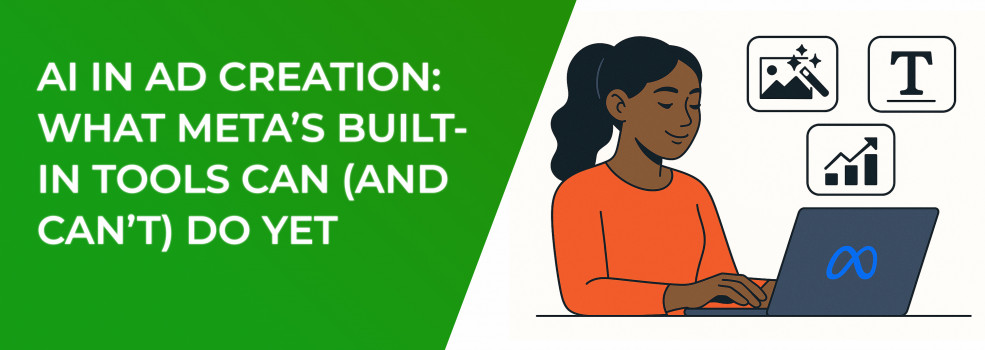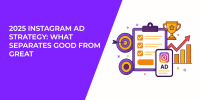If you’ve been chasing better Facebook ad performance this year, you’ve probably tested Meta’s growing set of AI shortcuts inside Ads Manager. From one-click Advantage+ creative tweaks to AI-generated images, the promise sounds irresistible: write a few lines, upload a product shot, and watch the machine spin out winning ads. But how much of that promise is real, and where does human strategy still win?
Why Meta Is Betting Big on Built-In AI
Advertising delivers about 97% of Meta’s revenue, so shaving even a few cents off the average cost per click or nudging conversion rates upward has an outsized payoff. The company’s push to automate ad creation, targeting, and budgeting sits inside the Meta Advantage+ suite.
For a wider look at the generative tools reshaping marketing, check out our comparison of today’s top platforms in The Best AI Text and Image Generators.
Here’s a quick snapshot of the core tools already live:
-
Background generation – drops your product into AI-made scenes for faster creative testing
-
Image variation and expansion – auto-sizes and reframes photos for every placement
-
Text generation – proposes up to five headline and primary-text options from your seed copy
-
Advantage campaign budget – shifts spend toward the ad sets most likely to hit your goals
Meta Advantage+ tools aim to automate ad creation, placement, and budgeting.
Taken together, these features aim to shorten production cycles, widen reach, and give smaller teams a realistic shot at enterprise-level efficiency.
What Meta’s AI Already Does Well
Before diving into the gaps, it helps to name the areas where AI is already pulling its weight. Early adopters report three clear wins:
Rapid, On-Brand Variations
Generative AI can turn a single product shot into dozens of backgrounds in seconds. Independent ecommerce brands that rotated at least three AI-generated scenes in one ad set recorded a 12% lift in click-through rate. Of course, great creative still needs the right eyes, see Facebook Ad Targeting 101: How to Reach the Right Audience for a refresher.
Placement-Ready Assets Without Designer Hours
Square, vertical, 4:5, 16:9 — the algorithm keeps subjects centered and text legible, saving hours of manual resizing and unlocking cheaper placements.
Predictive Budget Shifts
With Advantage campaign budget active, Meta continuously reallocates spend to the creative converting best, often edging out manual budget tweaks once learning stabilizes.
If you’re weighing whether to lean fully on automation, our playbook Scaling Facebook Campaigns with Advantage+ Budget Allocation breaks down real‑world results.
Where the Robots Still Need Human Supervision
Even the smartest system can fumble the finer points of brand stewardship. The most common snags fall into four buckets:
Recognizing these gaps helps marketers decide where to lean on automation and where to stay hands-on.
And if your automated ads stall out completely, our guide to Why You See “Ad Set May Get Zero” on Facebook and How to Fix It can get them moving again.
Five Tips to Boost Facebook Ad Performance Right Now
With strengths and weaknesses in view, here are five practical moves to keep AI working for you, not against you:
-
Lock your hero asset first, then let AI riff. A crisp product shot or UGC clip gives the algorithm a solid base
-
Set guardrails on text generation. Seed crucial phrases such as “free shipping” so headlines stay on brand
-
Verify your Facebook pixel. Clean conversion data is the fuel that powers downstream retargeting
-
Run one manual control ad in every campaign. It’s the fastest way to confirm that AI is beating human-made creative
-
Check the “Why this ad?” panel every week. Transparency tags now flag AI-edited images and can alert you to policy issues before they snowball
Following these habits keeps the tech in check and your brand in control.
The Metrics That Matter
Hard numbers ultimately decide whether an idea is worth scaling.
The best results come from AI-human collaboration, not full automation.
Focus on these indicators to judge success:
-
Click-through rate (CTR) – the fastest pulse check on thumb-stopping power
-
Average cost per click (CPC) – watch for cheap clicks that might trade quality for quantity
-
Cost per acquisition (CPA) and return on ad spend (ROAS) – give AI at least a month; it often needs extra runway
-
Cost per thousand impressions (CPM) – healthy CPMs hint that fresh creative stays relevant across placements
Monitoring this quartet offers a balanced view of both efficiency and profitability.
The Road Ahead
Meta is already piloting generative video that animates still images into full-screen Reels ads, aiming for a broader rollout later in 2025. Expect stronger copy tools, tighter brand-safety toggles, and more transparent reporting as advertisers demand predictability.
Bottom Line
Meta’s built-in AI can speed up asset production, fine-tune budgets, and nudge key performance metrics in the right direction. Treat it like a tireless, occasionally clueless intern: great at producing options, but still in need of human direction and clean data to truly shine.

